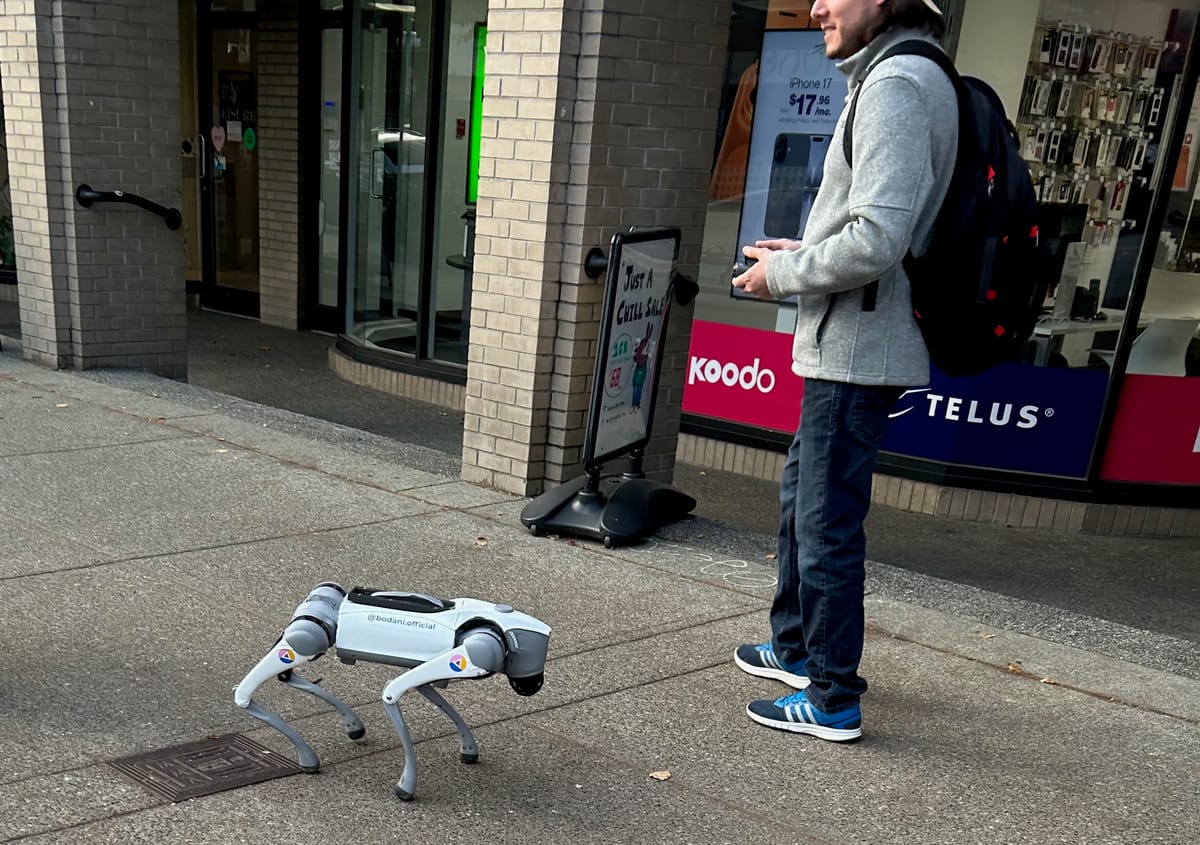
By Elke Porter | WBN Ai | October 8, 2025
Subscription to WBN or writing for WBN is always FREE!
Last week on the sun-dappled streets of Kitsilano, I encountered Alice—a bona fide robot dog that stopped me in my tracks. She trotted along the sidewalk with uncanny grace, her mechanical joints moving with surprising fluidity. When she started coming toward me, I instinctively moved aside. I have a fear of dogs, and despite Alice's obviously mechanical appearance, something about her movement triggered that primal response.
It was strange how real she seemed—not visually, but in the way she occupied space and moved with purpose. I had no idea what would happen if this thing kept coming and didn't stop! That unsettling encounter sent me down a research rabbit hole that led straight to Boston Dynamics and their remarkable creation: Spot.
Spot represents the pinnacle of professional-grade robotic companions. This quadruped marvel navigates complex terrains—stairs, rubble, factory floors—using three motors in each leg and an array of stereo cameras that build 3D maps in real-time. It can operate autonomously or via remote control, equipped with thermal sensors and customizable payloads that transform it from mere novelty into industrial workhorse. https://bostondynamics.com/
The closest precedent I'd encountered was back in 1995, when researchers attached tiny cameras to living cockroaches, directing them through electrical impulses to crawl under doors in hostage situations or through earthquake rubble to locate survivors. But that unsettling marriage of biology and technology felt ethically murky—exploiting living creatures as disposable tools. Robots are different. They're purpose-built, raising no questions of suffering or consent.
The applications are staggering. Spot conducts autonomous inspection rounds in power plants where radiation makes human presence dangerous. It assesses collapsed buildings for search and rescue teams, venturing where first responders cannot. In nuclear decommissioning sites, it becomes humanity's tireless scout, navigating hazards that would be lethal to living beings.
But here's what captivates me: Spot's safety features—emergency stops, audio-visual warning systems—reflect a design philosophy that imagines these robots coexisting with us. Boston Dynamics explicitly prohibits using Spot for harmful or intimidating purposes, recognizing that acceptance requires trust. The only thing I know for sure is that the dogs walking past this robot on the sidewalk did not seem to trust this thing. Some of them went ballistic, barking and baring their teeth.
As I watched Alice on that Vancouver sidewalk, I glimpsed of a not-too-distant future: robo horses pulling wagons in Stanley Park or carrying an RCMP Officer without the mess. There is also a big need for robot companions in care homes and hospitals serving allergy-sufferers, immunocompromised or even just lonely seniors with Alzheimers. Finally industrial sentinels like Spot are needed to keep humans safe as they work.
Our homes, our workplaces and our streets of tomorrow won't just accommodate these mechanical companions—they'll depend on them. How do you feel about this high-tech future coming toward you? I feel like that thing we always said during a rousing game of hide-and-go-seek: "Ready or not, here we come!"
Contact Elke Porter at:
Westcoast German Media
LinkedIn: Elke Porter or
WhatsApp: +1 604 828 8788.
Public Relations. Communications. Education
TAGS: #robot dogs, #Boston Dynamics Spot, #robotic companions #quadrapods #WBN Ai #WBN News Kitsilano #Elke Porter



